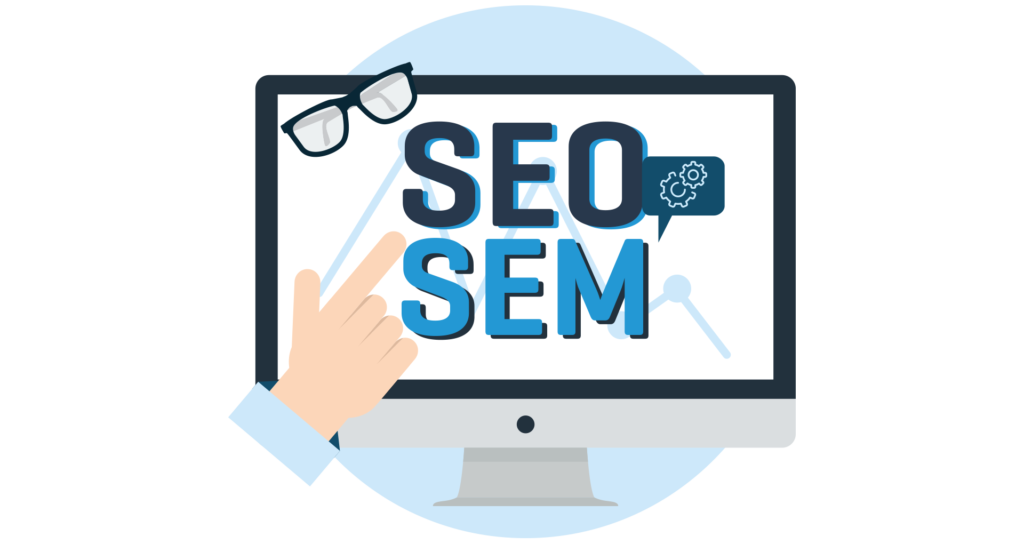Google provides excellent opportunities for businesses of all sizes to showcase themselves and gain visibility. So far, they can be classified into two main groups: paid search and organic search results.
If we take these two sections, Search Engine Optimization(SEO) aims to make you rank utilizing organic search. At the same time, you can position your business in the paid area through Pay-Per-Click (PPC) ads. Now, Search Engine Marketing (SEM) combines the elements of these two strategies.
The areas and cases where you can use SEO and SEM are pretty vast in number, as well as their differences. So, in this blog, we will try to cover what to choose when we put SEOvsSEM, how to use them, and what you should know about SEO in general.
What is SEO?
SEO, or search engine optimization, is putting all your efforts into ranking in search engines via organic searches. To rank through SEO, you have to cover four main points :
- Keyword Research: Keyword research aims to find words that will perfectly describe your business and fit users’ search intent. You can use keyword research tools such as Ahrefs, Google Keyword Planner, or Semrush to find keywords.
- On-Page SEO: On-Page SEO is where you actually poot your keywords to use. This means tailoring your page’s content around the keywords you found during your research. For example, You can include the focus keywords in title tags, meta descriptions, and URLs.
- Off-Page SEO: Off-Page SEO is used to make your website visible outside the scope of your page. The shortest and most common way to do so is through building backlinks, as they are among the top three factors based on which Google grants your ranking. For example, you can reach out to high-ranking websites to get backlinks for your blog posts.
- Technical SEO: Technical SEO ensures that Google or other search engines can crawl and index all of the pages on your website. Part of the technical SEO is ensuring that your pages load quickly and your site architecture is correct.
All the above-mentioned aspects are crucial for SEO if you want to harvest results. Keep in mind that you have to not only implement them but also work on them constantly to gain results. To make them even better, you can use search engine marketing as well.

What is Search Engine Marketing
For SEM, it is essential to remember that everything we mentioned about SEO applies here, as SEO is part of SEM. The only difference is that it involves, also the paid portion of advertising on Google. Here is when you have to know the key parts of SEM, too:
Bidding and Rankings: Ad rankings depend on your bid, as higher bids usually put ads above others. You only have to pay when someone clicks your ad. It’s known as Cost Per Click (CPC).

Quality Score: Google uses it to analyze the worthiness and relevance of your ad. It is primarily based on:
Ad Copy: Compelling ad copy is the key to success. Strong copy often grows your CTR, boosts your Quality Score, and lowers its costs. Weak copy brings lower Quality Scores and higher PPC costs.
Ad Groups and Optimization: Make the most of the data in your Google Ads account to tweak your campaigns and optimize ad spend.
SEO vs SEM: What to Choose
After establishing what SEO and SEM are, it is high time to understand which one will win the competition between SEO and SEM. The crucial thing here is to know that they both have advantages and are essential for business success and using one does not undermine the other. So, let’s dig in.
The main difference that should be highlighted between SEO and SEM is the timelines take time to work. SEO needs time to work. This is especially true for new sites with weak backlink profiles. In fact, studies reveal that it takes, on average, around two years to appear on the first page of Google—many, if not most, of the upfront titles have actually been published for over three years.
However, that doesn’t mean it will take two years for you to see movement. Some initial progress is often seen with focused long-tail keyword targeting and following the process. That said, SEO can also work if you trust the job to professional SEO services and find not only the perfect focus keyword but also get covered on all the key aspects.
On the other hand, while having SEM, more specifically PPC, you can, in almost an instant, have results. Turn on an ad in the morning, and voila, be pulling in traffic and conversions before noon. Conversely, optimizing it for positive ROI usually requires a few months of testing and tweaking. Still, it’s undeniably faster than SE for initial results, even at the front end.
How to Balance Both SEO and SEM
The key to answering this question is not simple. To begin, you have first to estimate your goals and then establish an appropriate SEO and SEM strategy.
SEM provides immediate results and is therefore ideal during, for example, product launches or campaigns of urgency, but organic traffic from search engine optimization builds gradual visibility with some sustainability traffic. You will know what to do with your money when you have an understanding of your objectives and timelines. They altogether fit hand in hand.
Take PPC, for instance; as you have activities in SEM, you can also test some keywords to perfect your SEO strategy. Also, use paid ads to create visibility for new content while waiting for organic rankings to catch up.

SEO and SEM investment must always be well-strategized; with the first, you focus on establishing evergreen content, generating backlinks, and optimizing your website for the search engines. In the case of SEM, allocate your budget to those high-converting keywords and audiences who will ensure an ROI to be proud of.
Not only does it add performance metrics to the programs, but performance monitoring would also be essential for both approaches. For SEO, track organic rankings, traffic, and conversions, while ROI and cost-per-acquisition for SEM should be analyzed for this. Use that data to hone your strategy and respond to the twists or turns of the time or market.
Finally, understand the journey of the user. SEM does well at the top end and is very good at raising awareness. SEO nurtures that lead over time with valuable, engaging content. Together, these two strengths can offer a complete marketing model, giving quick wins and longer-term victories.
Final Lines
Google gives businesses two distinct ways to advertise, mainly organic searches and paid searches. While SEO is mostly about getting traffic to organic searches, SEM includes paid ads. To choose between the two, you have to clearly define your budget and goals.